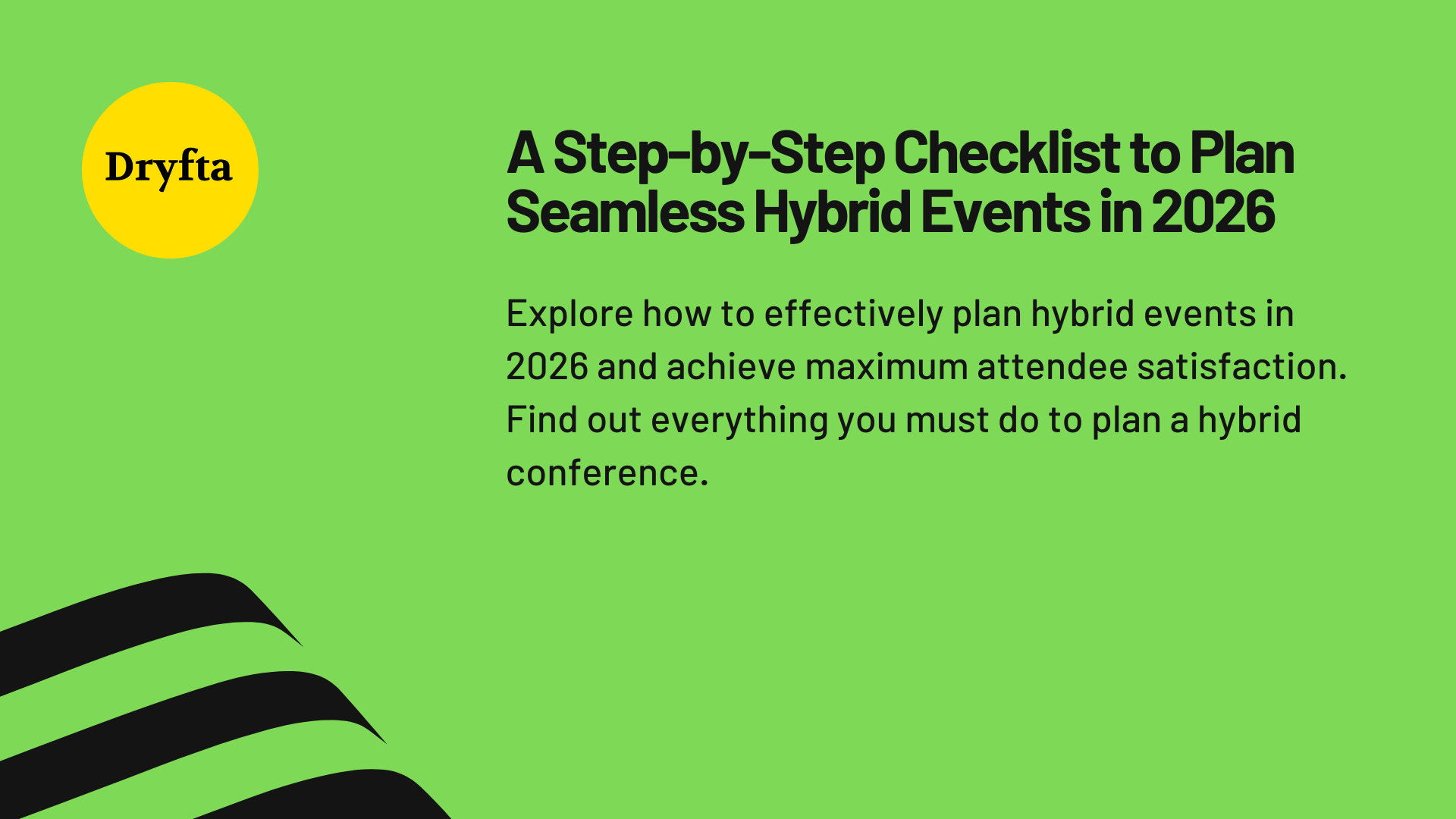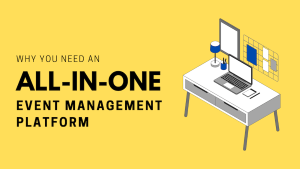
Thinking of planning your next hybrid event? We have a statistic that you’ll probably find insightful. According to Statista, 74.5% of event planners prefer hosting hybrid events as of 2025. Hence, you are in the correct direction if you think choosing hybrid events is the way forward.
However, many event organizers would also agree that planning such events is often too tedious. But hang in there! Ultimately, it all comes down to how well you plan your hybrid events and we have got you covered in this aspect. Let’s take you through this step-by-step guide to help you plan your next hybrid event in 2026 efficiently.
Steps to Plan an Unforgettable Hybrid Event
The process of planning a hybrid conference can be overwhelming for many organizers. However, the right strategy and tools can guide your event in the direction of success.
Step 1: Define Your Event Objectives
Don’t offer two separate experiences to the attendees simultaneously. Instead, present one complete event that caters to both virtual and in-person attendees efficiently. You need to carefully consider how every element of your academic event can influence both sets of audiences.
Ask yourself this question: What do I wish to achieve through this event? It can be enhancing brand awareness or educating your audience. Having complete clarity about your objectives will simplify the event planning process.
After you have chalked out your goals, learn about the Key Performance Indicators (KPI) to evaluate the success of your conference. The KPIs may include the following elements:
-
- The number of participants (virtual and in-person) in your event
- Participant engagement
- Post-event feedback
Step 2: Learn About Your Target Audience
Your attendees are the backbone of your event. This means you need to spend enough time learning about these individuals. If your audience belongs to a certain industry or geographic region, you need to keep that in mind when planning for the event. When hosting a hybrid event, you’ll have two sets of attendees: virtual and in-person. You need to consider the preferences of both of these sets of audiences.
Putting together a memorable hybrid event experience becomes a lot easier when you know what each group of the audience values.
Step 3: Select The Appropriate Tech Stack For Your Hybrid Events
Organizing a hybrid event means you need to pick a solid technology stack for constant connectivity throughout the event. A stable and flexible tech setup results in a better event experience, both online and offline. Mentioned below are some of the most essential elements of the tech stack that you should consider when hosting a hybrid event:
| Equipment for Streaming | Microphone, camera, stable internet and encoder. |
| Platform | Think about whether you need a browser-based solution, an app, or a combination of both. |
| Tools For Interaction | Surveys, virtual lounges, live chats, breakout rooms. |
It would be a wise idea to restrict the number of tools on your tech stack. In such cases, you can opt for all-in-one event management solutions like Dryfta. Our solutions simplify every aspect of your hybrid events. These aspects include:
-
- Abstract submission
- Attendee engagement
- Registration
- Post-event analytics
Make sure you test the tech stack well in advance. You wouldn’t want technical issues to appear in the middle of conference sessions. Always have backups, such as extra microphones, spare batteries and a plan B if the internet goes down.
Step 4: Decide on a Venue and Create a Layout
Always consider technology-related concerns when selecting a venue for your in-person attendees. Does the venue have enough space for streaming setups and cameras? Is the lighting good enough to capture clear videos? Does the venue have a stable internet connection?
Another important aspect is the layout of your event. See to it that the setup is compatible with both virtual and physical experiences. The placement of your camera should be in a direct line of sight to the stage and the sound should be crystal clear for both audiences. Find ways to include the virtual attendees to enhance their event experience. You can ask them to post live comments or questions through the streaming platform during different sessions at the venue.
Step 5: Come Up with an Efficient Agenda For Your Hybrid Events
A detailed event agenda is the most effective way to engage both in-person and virtual attendees. Here are some aspects to consider when working on your event agenda:
-
- Make sure your virtual attendees have access to on-demand recordings of different sessions.
- Refrain from having long sessions at your event. Break the sessions down with interactive elements such as Q&A sessions, live polls or short breaks for networking.
- The attention span of virtual attendees may be shorter as compared to that of in-person attendees. Hence, you must keep the overall pace of the event lively.
Step 6: Don’t Neglect Event Promotions
Once you have a plan in place, it’s time to promote the event. Your promotional strategy should focus on both virtual and in-person attendees. Use email campaigns, social media and your event website to build interest.
When promoting the event, highlight the benefits for both sets of attendees. For example, offer easy access to event content for virtual attendees. Similarly, provide networking opportunities for in-person attendees. You can provide special virtual passes, early bird tickets or exclusive access to certain content.
Overall, your marketing efforts should consider the hybrid nature of your event and offer value to both sets of audiences.
Step 7: Test Your Tech During the Event Again
You may have tested your tech stack multiple times, but still conduct another test on the day of the event. Check microphones, live streaming, video playback and even the wi-fi connection. You can also walk your speakers through the tech stack in advance to ensure they can handle any last-minute glitches.
Step 8: Pay Attention to Attendee Engagement
Event organizers may often find it challenging to keep both sets of audiences engaged. However, this is an essential aspect that determines whether your event is successful or not.
One way to maintain the attendee engagement is to rope in a host or moderator to keep the virtual audience involved. These moderators can connect with them during sessions through live polls or by asking questions. The experience should be inclusive for both audiences.
For instance, if you’re doing a live Q&A, you can take questions from both in-person attendees and the virtual ones. Encourage your speakers to acknowledge both groups to create a more complete experience.
Step 9: Provide Networking Opportunities For Both Audiences
Networking is a significant element that you can’t overlook while organizing the hybrid event. You don’t want your audience to miss out on engaging with fellow attendees.
You can host breakout sessions or invite in-person and virtual attendees to take part in group discussions. You can develop a mobile app for attendee networking.
Step 10: Monitor Engagement and Collect Feedback from Attendees
Evaluating engagement during hybrid events ensures real-time improvements and helps with post-event analysis. Use data to keep track of attendance, session popularity and interaction rates. This offers clarity on the involvement of both virtual and in-person attendees. Here are some of the elements you should be tracking:
-
- Measure active involvement of the attendees, including questions they asked and polls they took part in.
- Collect post-session ratings and comments.
- Find out when and where virtual attendees disengage.
Encourage attendees to share feedback using surveys and live chat features. Monitor the feedback to address any ongoing issues and ensure a smooth experience for the attendees. After the event, check the collected event data to determine successful aspects and areas that need attention.
This helps you customize your next hybrid event based on these learnings.
Parting Thoughts
Organizing hybrid events requires thorough planning, effective tech integration and seamless attendee engagement. You can consider Dryfta’s event management system to help you achieve your hybrid event goals.
Our comprehensive solutions ensure your hybrid events are successful. These solutions empower organizers to provide memorable experiences and increase attendee participation across all formats of the event. Schedule a free demo today.




